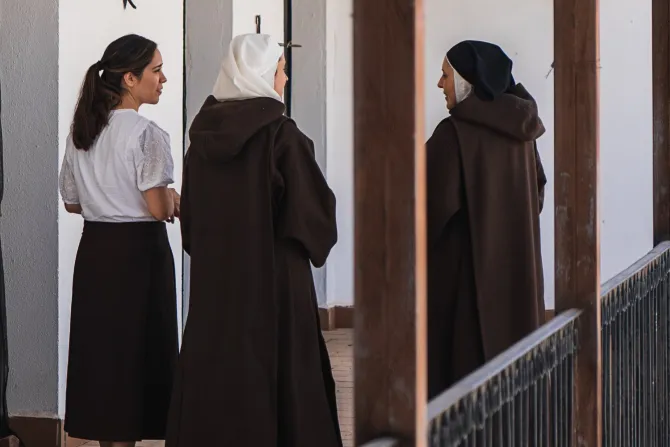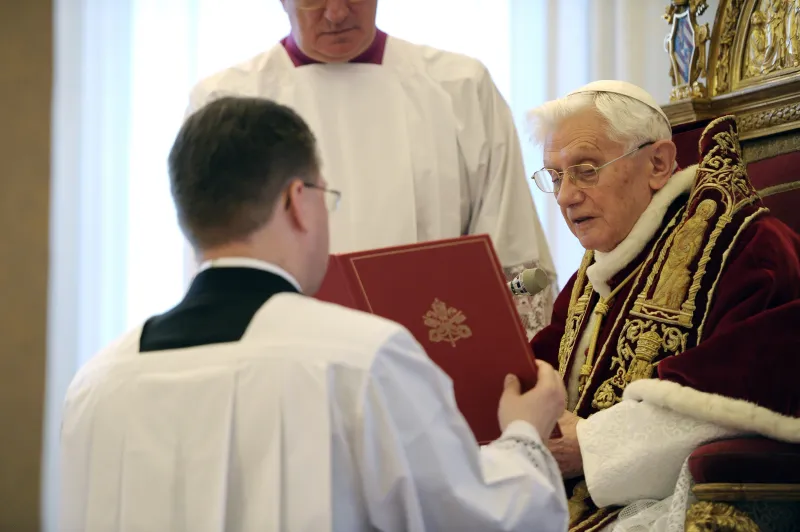Two Carmelite nuns in Spain seek to recover the hermitical origin of their order

 Mother Ana María and Sister Raquel, Carmelite hermits in Spain, together with a young postulant. / Photo courtesy of Mother Ana María and Sister Raquel
Mother Ana María and Sister Raquel, Carmelite hermits in Spain, together with a young postulant. / Photo courtesy of Mother Ana María and Sister Raquel ACI Prensa Staff, Oct 27, 2023 / 09:31 am (CNA).
Mother Ana María and Sister Raquel form a small Carmelite community that is currently looking for a place to fully live their vocation closer to the hermitical origins of the order on Mount Carmel, which is today surrounded by the city of Haifa in the Holy Land.
Both women entered the order as discalced Carmelites in Ávila, Spain, shortly after turning 18. Today, Mother Ana María, born in Madrid, is 54 and Sister Raquel, from Toledo, is 30. They make up a Carmelite hermit community that has had the pertinent canonical approval for three years.
During limited phone call hours, Sister Raquel told ACI Prensa, CNA’s Spanish-language news partner, “God willing, another sister will enter after Christmas.”
Both nuns had been “discerning this for a long time” and five years ago they began this journey in Ávila, where the diocese provided them with a provisional place to found the new community.
“We have a totally Carmelite charism, but with a marked eremitic character, that is, more time in the cell, in silence, in solitude within the convent,” the nun explained.
However, it wasn’t possible to find the necessary conditions there as, among other reasons, “there are few priests in Ávila” and they couldn’t serve them optimally. Thus, the sisters asked the Archdiocese of Toledo, where they have been temporarily given the parish house in the town of Consuegra, for a place to relocate.
The current space, despite being large, “is in the middle of the town and doesn’t have a garden or anything. There’s a lot of noise, we are surrounded by neighbors and of course, it’s not appropriate for us,” Sister Raquel said.
The search for a place to settle the new community is complicated, because most of the empty monasteries are in the middle of town and sell for a fairly high price.
Besides that, theirs is an almost unknown community: “Hardly anyone knows us, we have no benefactors, nor help,” she said. “Some priests support us,” as do some groups such as the Our Lady of Christendom association.
Beyond the project of finding a new monastery, there is the question of their own support. Both sisters do make liturgical vestments, chasubles, and purificators but on the side, not as an organized business. Therefore, they ask for donations through their website.
A more radical silence
What do these two nuns hope to find in hermitical life?
Sister Raquel said that “the contemplative life is dedicated above all to the cultivation of the interior life, which is so needed. First, for one’s own salvation and then also for love of the Church.”
At a time when “we see that the Church suffers so many things and that we are in very bad shape in many aspects, one of the most effective ways to contribute our grain of sand is sanctification itself,” she emphasized.
“So,” she continued, “what better way than to dedicate oneself radically and with all possible effort to one’s own sanctification to give that flower to the Church, right?”
For Sister Raquel, the hermetical life is “a plus within the contemplative life. It’s a more radical silence, a more radical withdrawal from the world” that includes, for example, shortening the time of visits by outsiders.
Ultimately, it’s about “recovering the original charism from Carmel, which at times has been relaxed a bit. It is the hermitical spirit of St. Elias and the early fathers,” Sister Raquel explained.
An open door to the world
The community’s daily schedule is not the world’s schedule.
The nuns rise at 5:00 a.m. The hours of the day are then dedicated to prayer and study. Holy Mass is at 9:00 a.m. followed by a time for work, more prayer, and spiritual reading. Lunch is at 1:00 p.m. and after a short break, the nuns return to work and meditate on Lectio Divina. After vespers, there is another time of meditation before dinner at 7:30 p.m. They then enjoy 30 minutes of recreation before praying Compline at 9:00 p.m. and then retire for the night.
Despite this rigor and its isolation from the world, the community would like to find an ideal location where they can also leave a door open to the world.
“We intend, if we find the right place, to offer young girls a closer experience of the contemplative life,” Sister Raquel said. They also hope to foster vocations to “be able to form girls in the preciousness of monastic life” and the cultivation of Gregorian chant.
They also keep a small opening to the world through a blog, where they have begun posting some reflections and propose examples of dedication to God such as that of the young girl, Corpus Solá y Valencia, known as “the Maria Goretti of Navarre,” who in 1943 gave her life to keep her virginity in the city of Olite.
“Many young girls are not spoken to about these issues, about giving their youth to God, etc. We, who live apart, don’t have any type of apostolate nor can we speak to people, nor catechize, and it occurred to us to write these entries,” she explained.
Recovering monastic life
Asked about the difficulty of vocational discernment for youth, the sister answered without hesitation: “It’s easier than it seems. There are girls who go around and around with it too much. Vocation is nothing more than a firm decision to follow Christ radically. No one should expect anything mystical or supernatural. It’s simply a firm decision.”
“We have to recover the monastic life,” Sister Raquel added, “because it is crucial at this time. It is one of the most effective ways the Church has put in place for the salvation of souls and for their flourishing.”
“For the love of the Church and for the love of souls, surrendering one’s life to God is the best thing that can be offered to the Lord,” she concluded.
This story was first published by ACI Prensa, CNA’s Spanish-language news partner. It has been translated and adapted by CNA.




